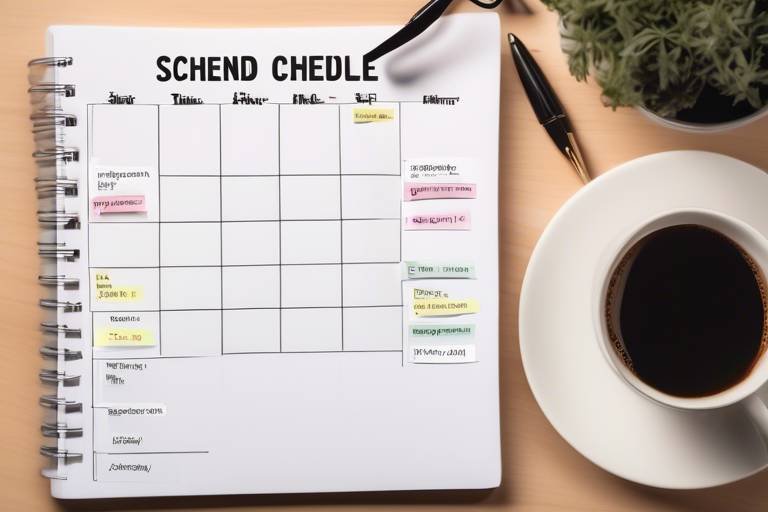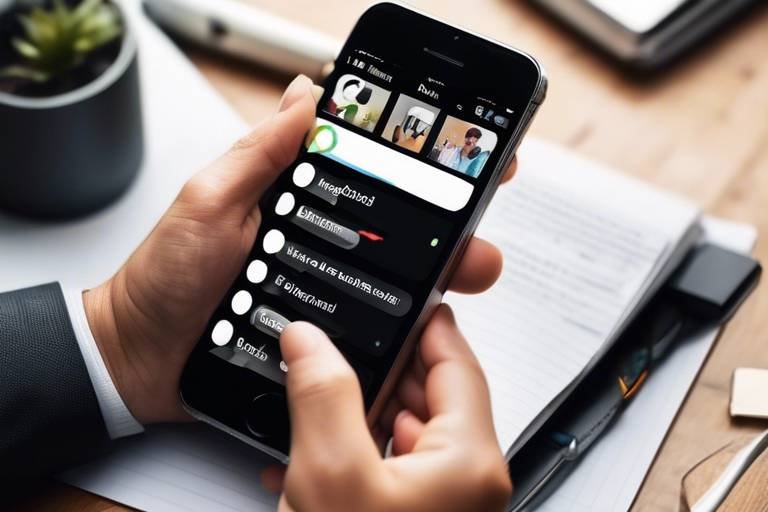How to Create a Personalized Productivity System
Creating a personalized productivity system is a journey that requires introspection, planning, and dedication. It's about tailoring your approach to productivity to fit your unique needs and preferences like a bespoke suit. By customizing your productivity system, you can unlock your full potential and achieve your goals with efficiency and ease.
When embarking on the quest to create your personalized productivity system, the first step is to assess your goals and priorities. Take a deep dive into what truly matters to you, both professionally and personally. Setting clear objectives will serve as the guiding star that aligns your productivity efforts with your aspirations, ensuring that every task you undertake contributes to your overarching goals.
Once you have a clear understanding of your objectives, it's time to choose the tools and techniques that will support your journey towards enhanced productivity. Just as a craftsman selects the finest tools for their trade, you must carefully curate the productivity tools and methods that resonate with your working style. Whether it's a sophisticated task management app or a simple pen and paper system, the key is to choose tools that enhance your efficiency and make your workflow seamless.
One powerful technique to supercharge your productivity is time blocking. By segmenting your day into dedicated time slots for specific tasks, you can maximize your focus and eliminate distractions. This method allows you to immerse yourself fully in the task at hand, leading to heightened productivity and tangible results.
Task prioritization is another cornerstone of a personalized productivity system. By categorizing tasks based on their importance and urgency, you can ensure that you tackle the most critical responsibilities first. This strategic approach prevents you from getting overwhelmed and helps you stay on track towards achieving your goals.
In today's digital age, embracing digital organization is essential for maintaining a clutter-free workspace and optimizing your workflow. From project management apps to cloud storage solutions, leveraging digital tools can streamline your tasks, boost collaboration, and keep you on top of your game.
Establishing effective habits is the glue that holds your productivity system together. By developing routines and rituals that support your goals, you can create a foundation for success. Whether it's starting your day with a morning meditation or ending it with a reflection session, cultivating positive habits will set you up for productivity triumph.
Regularly reviewing and adjusting your productivity system is crucial for long-term success. Just as a gardener tends to their plants, you must nurture and refine your system to ensure it stays relevant and effective. By evaluating your progress, identifying areas for improvement, and making necessary adjustments, you can continuously optimize your approach and achieve peak productivity.

Assess Your Goals and Priorities
In this article, we will explore the steps and strategies for developing a personalized productivity system that suits your unique needs and preferences.
When it comes to boosting productivity, the first step is to assess your goals and priorities. Take a moment to reflect on what truly matters to you. What are your long-term aspirations? By identifying these key elements, you can set clear objectives that will serve as the foundation for your personalized productivity system.
Imagine your goals as destinations on a map. Without a clear understanding of where you want to go, it's easy to get lost along the way. Setting specific goals helps you navigate the path towards success with purpose and direction.
Consider creating a table to list your top priorities and corresponding objectives. This visual representation can offer a clear overview of what you aim to achieve and how each goal aligns with your overall vision.
Remember, your productivity system should be tailored to support your goals and priorities. By aligning your daily tasks with your long-term objectives, you can work towards meaningful progress and fulfillment.
Now that you have a solid grasp of your goals and priorities, you are ready to move on to the next step in creating your personalized productivity system.
Selecting the right tools and techniques is essential in optimizing your productivity. Whether you prefer digital apps or traditional methods, it's important to choose tools that resonate with your working style and enhance your efficiency.
Think of your productivity tools as a craftsman's toolbox. Each tool serves a specific purpose and contributes to the overall quality of your work. By carefully selecting tools that complement your skills and preferences, you can maximize your productivity potential.
Consider creating a list of tools and techniques that you find most effective in your workflow. This list can serve as a reference point when optimizing your productivity system and experimenting with new methods.
Remember, the goal is not to overwhelm yourself with an abundance of tools, but to choose wisely and utilize them effectively to support your productivity goals.
By assessing your goals and priorities and choosing suitable tools and techniques, you are laying a strong foundation for a personalized productivity system that empowers you to achieve your full potential.
Stay tuned for answers to common questions about creating a personalized productivity system!

Choose Suitable Tools and Techniques
When it comes to enhancing your productivity, selecting the right tools and techniques is paramount. Your choice of tools can make a significant impact on how efficiently you work and how effectively you manage your tasks. Consider your unique working style and preferences to determine which tools and techniques will best suit your needs.
One of the fundamental tools for boosting productivity is a task management app. These apps allow you to create to-do lists, set reminders, and track your progress on various tasks. By having all your tasks organized in one place, you can prioritize effectively and ensure nothing slips through the cracks.
Calendar applications are also essential for scheduling your time effectively. Whether you prefer digital calendars or traditional planners, having a visual representation of your commitments and deadlines can help you stay on track and manage your time efficiently.
Additionally, consider incorporating note-taking tools into your productivity system. Whether you prefer digital note-taking apps or good old pen and paper, jotting down ideas, meeting notes, and important information can help you stay organized and retain crucial details.
For those who work collaboratively or need to communicate with team members, communication tools such as Slack, Microsoft Teams, or Zoom can streamline your interactions and ensure seamless communication, enhancing overall productivity.
Furthermore, automation tools can be a game-changer in simplifying repetitive tasks and freeing up your time for more critical activities. Explore tools like Zapier, IFTTT, or task automation features within your existing apps to automate routine processes and optimize your workflow.
Remember, the key is not just to adopt the latest productivity tools but to choose ones that align with your workflow and help you work smarter, not harder. Experiment with different tools and techniques to find what works best for you, and don't hesitate to adjust your system as needed to maximize your productivity potential.

Utilize Time Blocking
When it comes to boosting productivity and maximizing your efficiency, one powerful technique that can significantly enhance your focus is time blocking. Time blocking involves setting aside specific chunks of time for different tasks or activities, allowing you to concentrate on one task at a time without distractions.
By utilizing time blocking, you can create a structured schedule that helps you manage your time more effectively and make the most out of your day. This method enables you to prioritize your tasks based on their importance and allocate dedicated time slots for each task, ensuring that you stay on track and complete your work efficiently.
Imagine your day as a puzzle, with each task fitting into its designated time block like a perfectly placed piece. This approach not only helps you stay organized but also prevents you from feeling overwhelmed by a long list of to-dos. By breaking down your day into manageable segments, you can approach each task with a clear focus and a sense of purpose.
Moreover, time blocking allows you to create a balance between work and personal activities by scheduling time for both professional responsibilities and personal pursuits. By incorporating breaks and leisure activities into your schedule, you can maintain a healthy work-life balance and prevent burnout.
Overall, time blocking is a valuable strategy that can revolutionize the way you manage your time and enhance your productivity levels. By harnessing the power of focused time allocation, you can take control of your schedule, accomplish tasks more efficiently, and ultimately achieve your goals with precision and clarity.

Implement Task Prioritization
When it comes to maximizing productivity, implementing task prioritization is a crucial step in ensuring that you focus on the most important and urgent tasks at hand. By ranking your tasks based on their significance, you can effectively allocate your time and energy to tackle the responsibilities that will have the most significant impact on your goals.
Task prioritization involves assessing the importance and urgency of each task on your to-do list. By categorizing tasks into different levels of priority, you can create a clear roadmap for your day and avoid feeling overwhelmed by a long list of tasks.
One effective way to implement task prioritization is to use the Eisenhower Matrix, a decision-making framework that categorizes tasks into four quadrants based on their urgency and importance. By identifying tasks as urgent and important, important but not urgent, urgent but not important, or neither urgent nor important, you can quickly determine which tasks require immediate attention and which can be delegated or postponed.
In addition to using frameworks like the Eisenhower Matrix, it is essential to regularly reassess and adjust your task priorities as new deadlines emerge or circumstances change. Flexibility is key when it comes to task prioritization, as it allows you to adapt to unexpected challenges and stay focused on what truly matters.

Embrace Digital Organization
In this article, we will explore the steps and strategies for developing a personalized productivity system that suits your unique needs and preferences.
Identify what matters most to you and set clear objectives to align your productivity system with your aspirations.
Select productivity tools and methods that resonate with your working style and enhance your efficiency.
Allocate specific time slots for different tasks to maximize focus and productivity throughout your day.
Rank tasks based on importance and urgency to ensure you tackle the most critical responsibilities first.
Embracing digital organization involves leveraging digital apps and software to streamline your workflow, manage tasks, and maintain a clutter-free workspace. By utilizing tools like project management software, cloud storage solutions, and task management apps, you can enhance your productivity and efficiency in a digital environment.
Develop routines and habits that support your productivity goals and reinforce positive behaviors.
Incorporate mindfulness practices and regular breaks into your schedule to boost focus, creativity, and overall well-being.
Periodically evaluate your productivity system, make necessary adjustments, and fine-tune your approach for continuous improvement.
Coming soon...

Establish Effective Habits
Establishing effective habits is crucial for maintaining a successful productivity system. Just like a well-oiled machine, your habits can either propel you forward or hold you back. By cultivating positive routines, you can create a strong foundation for achieving your goals and maximizing your efficiency.
One effective habit to incorporate into your daily routine is setting specific and achievable goals. By breaking down your larger objectives into smaller, manageable tasks, you can track your progress and stay motivated. This approach not only helps you stay organized but also provides a sense of accomplishment as you tick off completed tasks.
Consistency is key when it comes to habit formation. Whether it's waking up at the same time every day, dedicating a specific time for exercise, or scheduling regular breaks, consistency breeds discipline and reinforces your commitment to productivity. Remember, habits are like muscles - the more you exercise them, the stronger they become.
Another essential habit to adopt is practicing self-care. Taking care of your physical and mental well-being is fundamental to sustaining high levels of productivity. Make time for activities that rejuvenate your mind and body, such as meditation, exercise, or hobbies. A well-rested and balanced individual is better equipped to tackle challenges and maintain focus throughout the day.
Furthermore, incorporating reflection into your routine can enhance your productivity system. Regularly reviewing your progress, identifying areas for improvement, and celebrating your achievements can provide valuable insights into your productivity patterns. This self-awareness allows you to adjust your strategies and habits accordingly, ensuring continuous growth and development.
In summary, establishing effective habits is a cornerstone of a personalized productivity system. By setting clear goals, maintaining consistency, prioritizing self-care, and reflecting on your progress, you can cultivate habits that support your productivity journey and lead to long-term success.

Practice Mindfulness and Breaks
When it comes to enhancing productivity, it's not just about working harder or longer hours. Taking breaks and practicing mindfulness are essential components of a well-rounded productivity system. Mindfulness involves being fully present and engaged in the moment, which can help reduce stress, improve focus, and boost creativity. By incorporating mindfulness practices into your daily routine, you can cultivate a sense of calm and clarity that will positively impact your work.
Additionally, taking breaks throughout the day is crucial for maintaining high levels of productivity. Stepping away from your work allows your brain to recharge and refocus, preventing burnout and increasing overall efficiency. Whether it's a short walk, a quick meditation session, or simply closing your eyes for a few minutes, giving yourself permission to take breaks can lead to significant productivity gains in the long run.

Regularly Review and Adjust
Regularly reviewing and adjusting your productivity system is crucial for maintaining its effectiveness and relevance to your evolving needs. By periodically evaluating how well your system is working for you, you can identify areas that need improvement and make necessary adjustments to optimize your workflow.
One effective way to review your productivity system is to track your progress towards your goals. This can be done by setting key performance indicators (KPIs) or metrics that align with your objectives. By regularly monitoring these metrics, you can gauge the effectiveness of your system and make informed decisions on what changes are needed.
Another important aspect of reviewing and adjusting your productivity system is seeking feedback from others. Whether it's colleagues, mentors, or friends, getting an outside perspective can provide valuable insights into areas you may have overlooked or ways to enhance your system further.
Additionally, staying informed about new productivity tools and techniques can help you stay ahead of the curve and incorporate innovative strategies into your system. Being open to experimentation and trying out new methods can lead to breakthroughs in productivity and efficiency.
Remember, productivity is not a one-size-fits-all solution, and what works for one person may not work for another. Regularly reviewing and adjusting your productivity system ensures that it remains tailored to your specific needs and continues to support your goals effectively.
Frequently Asked Questions
- What is a personalized productivity system?
A personalized productivity system is a tailored approach to managing your tasks, goals, and time in a way that best suits your individual preferences and needs. It involves identifying your priorities, selecting suitable tools and techniques, establishing effective habits, and regularly reviewing and adjusting your system for optimal productivity.
- How can I assess my goals and priorities effectively?
To assess your goals and priorities effectively, take time to reflect on what truly matters to you, both personally and professionally. Set clear objectives that align with your values and aspirations. Break down larger goals into smaller, manageable tasks, and consider using techniques like goal setting frameworks or journaling to track your progress.
- Why is time blocking important in a productivity system?
Time blocking is crucial in a productivity system as it helps you allocate specific time slots for different tasks, allowing you to focus on one task at a time without distractions. By organizing your day into structured blocks of time dedicated to specific activities, you can enhance your efficiency, reduce procrastination, and make better use of your available time.
- How can digital organization tools improve productivity?
Digital organization tools, such as task management apps, calendar software, and cloud storage solutions, can streamline your workflow, enhance collaboration, and ensure easy access to important information. By digitizing your tasks, schedules, and documents, you can declutter your physical space, stay organized, and boost overall productivity.
- Why is it essential to practice mindfulness and take breaks?
Practicing mindfulness and taking regular breaks are essential for maintaining focus, reducing stress, and enhancing overall well-being. Mindfulness techniques, such as meditation or deep breathing exercises, can help you stay present and attentive to your tasks. Breaks, on the other hand, allow your mind to rest and recharge, preventing burnout and improving creativity.

















